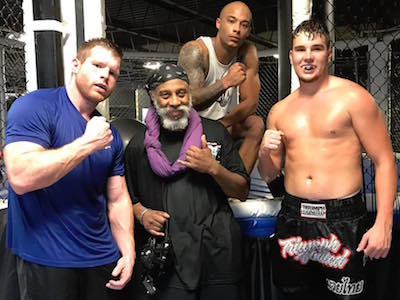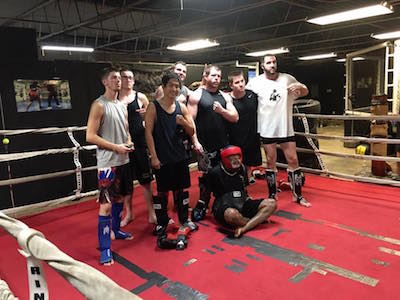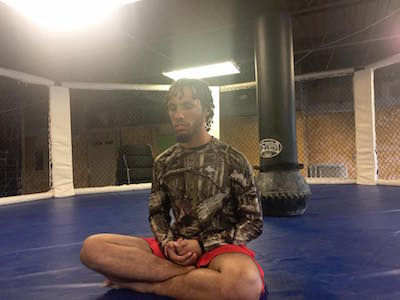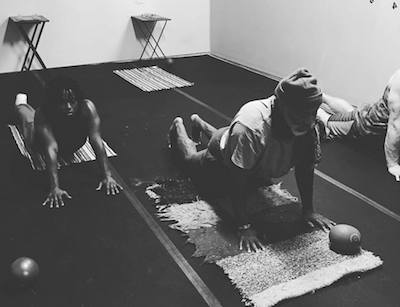Everything on the breath. Everything… This is the way of the Internal MMA Boxer. An Internal MMA Boxer is an adept who emphasizes the science of respiration control to enhance mental, emotional and physical performance in the ring and cage. These training resources are considered a vital step in the process of combative readiness. Being a retired Army Ranger I know from experience that Western MMA standards of performance are used by the U.S. Military with astounding results of martial performance. An emphasis on breath control taught in a scientific manner to control modal behavior is taught to troops. In the Temple Underground Gym that concept is even more profoundly explored and applied in combative and combat sport training.
At Temple Underground Internal Boxing Gym breath science is being tested inside the ring and cage with varying degrees of intensity and success. The method is called Western Long Boxing. When applied solely for Cage Fighting it is called Internal MMA Boxing and we have fighters who are using this method. The importance of practicing MMA in an internal manner is that the adept will be able to continue the MMA Boxing training well into their seasoned years and grow stronger and more healthy for the effort.

The result of direct internal boxing or martial energetic training of the Western Long Boxing method was a Valor Fights promotion event “Fight of the Night” (Chris Buttry) and Cruiser Heavyweight championship victory (Lance Abbott). True power is what Rickson Gracie BJJ Yoga has and teaches because the opponent senses danger in what cannot be seen but only felt… and by that time it is too late to secure the victory. Training and learning is continuous even beyond the state of competence. I am still learning how to do this through my new mentor Master Vic Hoti (Wing Chun, Escrima and BJJ instructor) who has trained many MMA fighters using similar methods. However, in the West Gracie is the most prominent MMA fighter to emphasize breath as an essential to stillness and motion in a way we can practically use. More importantly is to make the effort to learn and build upon his great work. You see Mixed Martial Arts is more than mere competition. When done correctly it is a warrior way of life.
For the warrior compassion is the highest form of martial discipline. Discipline is how a warrior expresses love of self and respect for others. Humility is not just a word for a warrior. It is the result of experiences that he or she has overcome with regard to sustaining mental, physical and emotional attacks. It is the realization that there is always someone better and so one must continuously engage and persevere. The victory in the struggle is to reveal the enemy within which is fear of change. This is the warrior way of life. As a warrior way of life the best of us are endeavoring to use this beloved discipline to make ourselves better people. Better fathers and mothers. Better leaders and friends. Better servants of nobility and providers for our families. Only a fool fights for personal glory as the ultimate goal because the wisdom is clear on the subject: All glory is fleeting…

It is hard for those who fight only to gain personal attention and/or prove their power to buy into anything internal. However, there are adepts who can demonstrate that there is substance to the term “internal”. In the MMA game the substance must be evident in mental, physical and emotional performance. Taiji, Bagua, Yoga and Qigong are internal or energetic disciplines. Integrate and create a program wherein they supplement the combative necessities of the ring and cage and create the possibility of substance. These internal disciplines are frankly bullshyte unless they are skills that can be observed, measured and replicated through external exercise or discipline. If the internal skills supplement an external discipline set to MMA cage performance standards then we have a plan of action worthy of review.
The internal/external merger must be subject to process. An effective internal boxing discipline is a science that can be used in the ring and cage; moreover, it allows for fast recovery from intense training sessions and post competitive practices. We at the Temple call this the science of energetics and we work to perfect this science to improve cognitive (mental), affect (emotional) and kinetic (physical) performance. If the energetics increase martial mental, physical and emotional performance then they have worth. Controlling breath during intense stillness (i.e. grappling control in the guard) and motion (i.e. relentless striking pressure) is a worthy endeavor to master. For my fighters it has been the difference between victory and defeat in challenging matches.

Internal MMA Boxing focuses on controlling the breath before, during and after explosions of energy in pugilistic striking and grappling. In the book, Western Long Boxing: Tao of Ten Gated Changes, this is discussed in detail. The breath is controlled through connecting (continuous) rhythmic movement of arms and legs during movement. In stillness it is controlled through sensing and following the movement of the heart through visualization. Working armed and unarmed martial resources is how the energetics are actualized… made real. But it all begins with the breath being manipulated in the upper, middle, lower and lateral parts of the torso. Anyone who has the experience of being on the receiving end of ground and pound while being stacked knows the value of mastering the breath on these levels. The exacting methods of Vedic breathing patterns are taught through the Taoist method of San Bao or “Three Treasures”.
At the Temple the three treasures are essence (harness sexual impulse), energy (align the spine in standing and prone postures) and vitality (maintaining intensity between anaerobic, aerobic, plyometric, eccentric action). We sit and breathe in specific ways to gather energy. We use specific postures of standing and prone to refine essence into energy. We cultivate energy into vitality through specific movements in weapons drilling, striking drilling and grappling drilling. The breath is manipulated as an expression of stilled posture alignment and motion intensity execution. We teach the appropriate breathing pattern for the expression of stilling and movement. The breath affects thoughts and emotions way beyond the physical conditioning phase of competence. It focuses thinking to endure the distractions of an offending opponent. It converts emotions (spirit) into feelings (energy) that can be used extend the limits of endurance, suppleness, strength and stamina.

Martial and energetic regimens must be performed within the numeric alchemy of time, space and repetition. Examples are setting the goal of 108 minutes of sustained training, breaking that sustained training into 36 minute sets, placing a focused attention 9 feet in front of you on the ground when pugilistically running and synching breath to three steps or strikes each for inhalation and exhalation. The ancients say that a fuller modal behavior potential can be unlocked by following this numeric alchemy. All the fighters at Temple Underground undergoing the process are experiencing significant performance results. This can be seen mostly through the young pugilists’ performances on the Facebook page for Temple Underground Internal Boxing.
You can watch them ignore bells that call for the end of the round and continue working at frenetic paces. You can see a near 60-year-old coach literally fight for over 15 minutes straight without break or fatigue. You will see cage pankration methods that are seemingly endless. The goal is not to build cardio. It is to make cardio irrelevant in the schema and goal of consciously entering a zone, a meditative flow state. At the Temple this is part of the process that emphasizes breath in stilling and moving meditation.

The foundation of these practices of breath control begins in the gathering of essence phase and builds from there. Nasal manipulation increases health. Retention of air increases awareness. Cessation of breath controls excessive responses to stimulus. These are just a few descriptions of the, foundational, breath manipulating process. Diet, rest and regular visits to TCM doctors supplement the efforts to maintain health, raise awareness and regulate overstimulation. It is said that martial science is not an art until it can be performed from apposition of weakness. Temple Underground fighters are known as strikers with the ability to neutralize most attempts to submit them on the ground. Valor cages are small and the opportunity to exercise movement limiting so they find themselves, often, at a substantial disadvantage. Certain training resources create simulation situations that help in the application of energetic breathing methods discussed.
Pilates Ball striking and rolling is supplemented by large medicine ball breathing-posture and Yoga/Qigong regimens. Heavybag, moving and speedbag work is supplemented by Weighted Punch-runs and Tire flip/pulls. Heavy stick drills connects breath and limb movement to unprecedented flow-states (In the Zone) which intensifies rhythmic endurance that has “hand and foot arriving at the same time”. Sparring is used to ensure martial and energetic competence mainly on the affect behavior (emotional) level of performance. The specific methods can be found being taught at Temple Underground Internal Boxing Gym.
Temple Underground Internal Boxing Gym is located at 230 Lincoln Ave, Morristown, Tenn. The literature that explains specifics is found through the following link. Also, check out the Temple Underground Magazine & Journal site.
